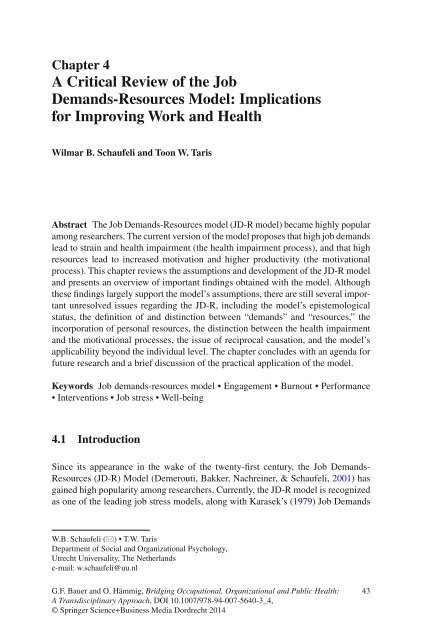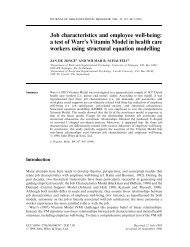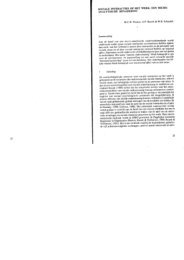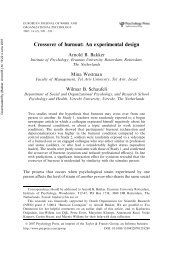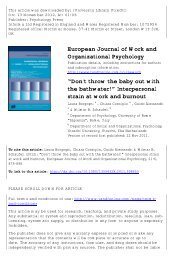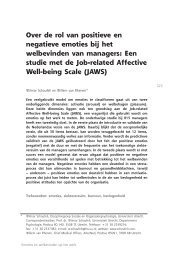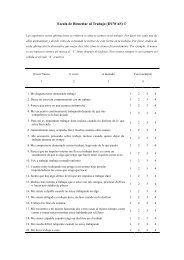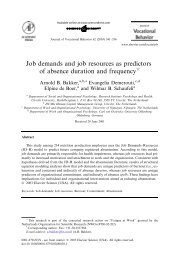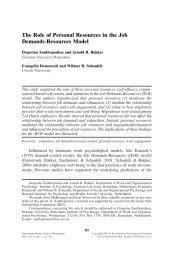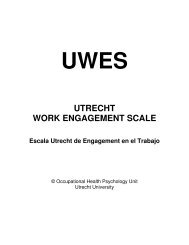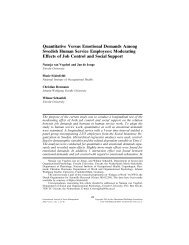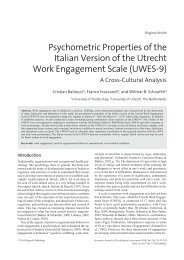A Critical Review of the Job Demands-Resources Model ...
A Critical Review of the Job Demands-Resources Model ...
A Critical Review of the Job Demands-Resources Model ...
You also want an ePaper? Increase the reach of your titles
YUMPU automatically turns print PDFs into web optimized ePapers that Google loves.
Chapter 4A <strong>Critical</strong> <strong>Review</strong> <strong>of</strong> <strong>the</strong> <strong>Job</strong><strong>Demands</strong>-<strong>Resources</strong> <strong>Model</strong>: Implicationsfor Improving Work and HealthWilmar B. Schaufeli and Toon W. TarisAbstract The <strong>Job</strong> <strong>Demands</strong>-<strong>Resources</strong> model (JD-R model) became highly popularamong researchers. The current version <strong>of</strong> <strong>the</strong> model proposes that high job demandslead to strain and health impairment (<strong>the</strong> health impairment process), and that highresources lead to increased motivation and higher productivity (<strong>the</strong> motivationalprocess). This chapter reviews <strong>the</strong> assumptions and development <strong>of</strong> <strong>the</strong> JD-R modeland presents an overview <strong>of</strong> important findings obtained with <strong>the</strong> model. Although<strong>the</strong>se findings largely support <strong>the</strong> model’s assumptions, <strong>the</strong>re are still several importantunresolved issues regarding <strong>the</strong> JD-R, including <strong>the</strong> model’s epistemologicalstatus, <strong>the</strong> definition <strong>of</strong> and distinction between “demands” and “resources,” <strong>the</strong>incorporation <strong>of</strong> personal resources, <strong>the</strong> distinction between <strong>the</strong> health impairmentand <strong>the</strong> motivational processes, <strong>the</strong> issue <strong>of</strong> reciprocal causation, and <strong>the</strong> model’sapplicability beyond <strong>the</strong> individual level. The chapter concludes with an agenda forfuture research and a brief discussion <strong>of</strong> <strong>the</strong> practical application <strong>of</strong> <strong>the</strong> model.Keywords <strong>Job</strong> demands-resources model • Engagement • Burnout • Performance• Interventions • <strong>Job</strong> stress • Well-being4.1 IntroductionSince its appearance in <strong>the</strong> wake <strong>of</strong> <strong>the</strong> twenty-first century, <strong>the</strong> <strong>Job</strong> <strong>Demands</strong>-<strong>Resources</strong> (JD-R) <strong>Model</strong> (Demerouti, Bakker, Nachreiner, & Schaufeli, 2001 ) hasgained high popularity among researchers. Currently, <strong>the</strong> JD-R model is recognizedas one <strong>of</strong> <strong>the</strong> leading job stress models, along with Karasek’s ( 1979 ) <strong>Job</strong> <strong>Demands</strong>W. B. Schaufeli (*) • T. W. TarisDepartment <strong>of</strong> Social and Organizational Psychology,Utrecht Universality, The Ne<strong>the</strong>rlandse-mail: w.schaufeli@uu.nlG.F. Bauer and O. Hämmig, Bridging Occupational, Organizational and Public Health:A Transdisciplinary Approach, DOI 10.1007/978-94-007-5640-3_4,© Springer Science+Business Media Dordrecht 201443
44W.B. Schaufeli and T.W. TarisControl (JD-C) model and Siegrist’s ( 1996 ) Effort Reward Imbalance (ERI) model.For instance, a search in Google Scholar in September 2013 revealed that twoseminal papers that discussed <strong>the</strong> JD-R model (Demerouti et al., 2001 ; Schaufeli &Bakker, 2004 ) had been cited more than 2,400 times.How can this popularity be explained? One likely reason is that like <strong>the</strong> JD-C andERI models, <strong>the</strong> JD-R model assumes that employee health and well-being resultfrom a balance between positive (resources) and negative (demands) job characteristics.As <strong>the</strong>se two earlier models had already sensitized <strong>the</strong> hearts and minds <strong>of</strong> researchersand practitioners to <strong>the</strong> notion <strong>of</strong> balance, <strong>the</strong> JD-R model fell on fertile ground. Yet,unlike <strong>the</strong>se two models, <strong>the</strong> JD-R model does not restrict itself to specifi c jobdemands or job resources. It assumes that any demand and any resource may affectemployee health and well-being (for an overview, see Appendix ). Thus, <strong>the</strong> scope <strong>of</strong><strong>the</strong> JD-R model is much broader than that <strong>of</strong> o<strong>the</strong>r models, because it potentiallyincludes all job demands and job resources. The JD-R model is also more flexibleand can be tailored to a much wider variety <strong>of</strong> work settings. The broad scope <strong>of</strong> <strong>the</strong>model appeals to researchers, just as its flexibility is attractive to practitioners.A second, somewhat problematic, explanation for its popularity is <strong>the</strong> relativelyloose way in which <strong>the</strong> label “<strong>Job</strong> <strong>Demands</strong>-<strong>Resources</strong> model” has been used.As we will show below, <strong>the</strong>re is actually no single JD-R model. Instead <strong>of</strong> relatingwell- defined and specific sets <strong>of</strong> concepts to each o<strong>the</strong>r (as applies to <strong>the</strong> ERI andJD-C models), <strong>the</strong> JD-R model is heuristic in nature and represents a way <strong>of</strong> thinkingabout how job (and recently also personal) characteristics may influenceemployee health, well-being, and motivation. This implies that even if two studiesshow no overlap in terms <strong>of</strong> <strong>the</strong> study concepts, <strong>the</strong>y could still be based on and test<strong>the</strong> same assumptions <strong>of</strong> <strong>the</strong> JD-R model.The heuristic use <strong>of</strong> <strong>the</strong> JD-R model in combination with its broad scope andflexibility presumably accounts for its current proliferation in both research andpractice. Yet, this wide applicability and usefulness do not imply that <strong>the</strong>re is noroom for improvement <strong>of</strong> <strong>the</strong> model. This chapter starts with a brief history <strong>of</strong> <strong>the</strong>JD-R model and <strong>the</strong>n addresses unresolved issues and <strong>of</strong>fers critical comments.The chapter concludes with some implications <strong>of</strong> <strong>the</strong> JD-R for improving workand health.4.2 A Brief History <strong>of</strong> <strong>the</strong> JD-R <strong>Model</strong>4.2.1 The Early JD-R <strong>Model</strong>The JD-R model was first published under that label by Demerouti et al. ( 2001 ) inan attempt to understand <strong>the</strong> antecedents <strong>of</strong> burnout. Their model drew upon Leeand Ashforth’s ( 1996 ) meta-analysis, in which eight “job demands” and thirteen“job resources” were identified as possible causes <strong>of</strong> burnout, and on <strong>the</strong> “structuralmodel <strong>of</strong> burnout” that was presented in <strong>the</strong> Maslach Burnout Inventory test
4 A <strong>Critical</strong> <strong>Review</strong> <strong>of</strong> <strong>the</strong> <strong>Job</strong> <strong>Demands</strong>-<strong>Resources</strong> <strong>Model</strong>…47treated as a unitary instead <strong>of</strong> a two-dimensional construct. Moreover, in line with<strong>the</strong> burnout literature (e.g., Melamed, Shirom, Toker, Berliner, & Shapira, 2006 ), itis assumed that burnout will lead to health problems, such as depression, cardiovasculardisease, or psychosomatic complaints. Thus, burnout is expected to mediate<strong>the</strong> relation between job demands and employee health and well-being (at leastpartly), through <strong>the</strong> gradual draining <strong>of</strong> mental resources (i.e., burnout). This is <strong>the</strong>energetic or health impairment process <strong>of</strong> <strong>the</strong> revised JD-R model.Similarly, a motivational process operates that is sparked by abundant jobresources. The revised JD-R model emphasizes <strong>the</strong> inherently motivational qualities<strong>of</strong> job resources. Following effort-recovery <strong>the</strong>ory (Meijman & Mulder, 1998 ),work environments that <strong>of</strong>fer many resources foster workers’ willingness to dedicate<strong>the</strong>ir efforts and abilities to <strong>the</strong> work task. Thus, job resources play an extrinsicmotivational role, because <strong>the</strong>y initiate <strong>the</strong> willingness to spend compensatoryeffort, <strong>the</strong>reby reducing job demands and fostering goal attainment. That is, jobresources are instrumental in achieving work goals. However, <strong>the</strong>y also play anintrinsic motivational role, because <strong>the</strong>y satisfy basic human needs for autonomy,relatedness, and competence (Deci & Ryan, 2000 ; Van den Broeck, Vansteenkiste,De Witte, & Lens, 2008 ). For instance, feedback may promote learning, <strong>the</strong>rebyincreasing job competence, whereas decision latitude and social support satisfyneeds for autonomy and relatedness, respectively. In both cases job resources stimulatea fulfilling, positive work-related state <strong>of</strong> mind (i.e., work engagement), ei<strong>the</strong>rthrough <strong>the</strong> achievement <strong>of</strong> work goals or <strong>the</strong> satisfaction <strong>of</strong> basic needs. In turn,this affective-motivational state fosters positive organizational outcomes, such asorganizational commitment and performance. So engagement is assumed to mediate<strong>the</strong> relation between job resources and organizational outcomes.4.3 Cross-Sectional EvidenceMost early research on <strong>the</strong> JD-R was cross-sectional in nature. The first studies on<strong>the</strong> revised JD-R model were conducted in <strong>the</strong> Ne<strong>the</strong>rlands with call-center employees(Bakker, Demerouti, & Schaufeli, 2003 ), industrial workers (Bakker, Demerouti, deBoer, & Schaufeli, 2003 ), and health care staff and white collar workers (Schaufeli& Bakker, 2004 ) and provided strong evidence for <strong>the</strong> assumptions <strong>of</strong> <strong>the</strong> model.These findings were almost perfectly replicated for o<strong>the</strong>r countries, cultures andoccupational groups, including Finnish teachers (Hakanen, Bakker, & Schaufeli, 2006 ),Australian volunteers (Lewig, Xanthopoulou, Bakker, Dollard, & Metzer, 2007 ),Austrian blue-collar and white-collar workers (Korunka, Kubicek, Schaufeli, &Hoonakker, 2009 ), Belgian blue-collar and white-collar workers (Hansez & Chmiel,2010 ), Chinese blue-collar workers and health pr<strong>of</strong>essionals (Hu, Schaufeli, &Taris, 2011 ), and Chinese family-owned business workers (Hu & Schaufeli, 2011 ).Moreover, <strong>the</strong> main parameters <strong>of</strong> <strong>the</strong> JD-R model were largely invariant acrossDutch and Spanish employees (Llorens, Bakker, Schaufeli, & Salanova, 2006 ). In total<strong>the</strong>se cross-sectional studies included 16 samples, and in only four cases partial
4 A <strong>Critical</strong> <strong>Review</strong> <strong>of</strong> <strong>the</strong> <strong>Job</strong> <strong>Demands</strong>-<strong>Resources</strong> <strong>Model</strong>…49assume that human behavior results from an interaction between personal andenvironmental factors, it was only to be expected that personal resources would beintegrated into <strong>the</strong> JD-R model. Personal resources are defined as <strong>the</strong> psychologicalcharacteristics or aspects <strong>of</strong> <strong>the</strong> self that are generally associated with resiliency andthat refer to <strong>the</strong> ability to control and impact one’s environment successfully. Similarto job resources, personal resources are functional in accomplishing work goals,and <strong>the</strong>y stimulate personal growth and development. To date, personal resourceshave been integrated into <strong>the</strong> JD-R model in five ways:1. Personal resources directly impact well-being. As personal resources are defined interms <strong>of</strong> resiliency and control, <strong>the</strong>y may reduce burnout and increase engagement.In a study among Spanish teachers, Lorente, Salanova, Martinez, and Schaufeli( 2008 ) found that emotional and mental competencies at <strong>the</strong> beginning <strong>of</strong> <strong>the</strong> academicyear predicted levels <strong>of</strong> burnout and engagement at <strong>the</strong> end <strong>of</strong> that year,controlling for baseline levels <strong>of</strong> demands and resources. Similarly, Xanthopoulou,Bakker, Demerouti, and Schaufeli ( 2009 ) reported in an 18-month longitudinalstudy that personal resources (self-efficacy, optimism, and organization- based selfesteem)predicted later work engagement, next to job resources (control, supervisorycoaching, feedback, and opportunities for development).Interestingly, Xanthopoulou et al. ( 2009 ) also found that work engagementpredicted personal resources across time. This reciprocal relation points to adynamic interplay <strong>of</strong> resources and engagement across time and, hence, to <strong>the</strong>existence <strong>of</strong> a gain cycle – that is, <strong>the</strong> (perceived) availability <strong>of</strong> resources fostersengagement, which in turn has a positive impact on (ei<strong>the</strong>r <strong>the</strong> presence or <strong>the</strong>perception <strong>of</strong>) resources, etc. (Salanova, Schaufeli, Xanthoupoulou & Bakker,2010 ). This notion <strong>of</strong> gain cycles originates from Hobfoll’s ( 2002 ) Conservation<strong>of</strong> <strong>Resources</strong> <strong>the</strong>ory, a motivational <strong>the</strong>ory that explains how people strive tomaintain and accumulate resources <strong>of</strong> various kinds, including job resources.2. Personal resources moderate <strong>the</strong> relation between job characteristics and wellbeing.The definition <strong>of</strong> personal resources implies that <strong>the</strong>y may buffer negativeeffects <strong>of</strong> job demands on burnout and exacerbate positive effects <strong>of</strong> job resourceson engagement. This reasoning was supported in a study with a representativesample <strong>of</strong> Dutch employees, where intrinsic work motivation streng<strong>the</strong>ned <strong>the</strong>negative effect <strong>of</strong> learning opportunities on exhaustion and increased <strong>the</strong> positiveeffect <strong>of</strong> job autonomy on work engagement (Van den Broeck, Van Ruysseveldt,Smulders, & De Witte, 2011 ). Fur<strong>the</strong>r, Brenninkmeijer, Demerouti, Le Blanc,and Van Emmerik ( 2010 ) found that <strong>the</strong> detrimental effects <strong>of</strong> workload andinterpersonal conflict on exhaustion were more pronounced for employeeshaving a strong prevention focus (i.e., who are concerned with obligations andresponsibilities). However, instead <strong>of</strong> exacerbating <strong>the</strong> positive effect <strong>of</strong> jobresources on engagement, a strong promotion focus (i.e., high concern withpossibilities for growth) was associated with lower levels <strong>of</strong> engagement.Brenninkmeijer et al. suggested that this may be due to a ceiling effect, sinceemployees having a strong promotion focus already experience high levels <strong>of</strong>engagement, which may preclude fur<strong>the</strong>r increases in engagement.
50W.B. Schaufeli and T.W. Taris3. Personal resources mediate <strong>the</strong> relation between job characteristics and well- being.Conservation <strong>of</strong> <strong>Resources</strong> <strong>the</strong>ory (Hobfoll, 2002 ) proposes that resourcestend to accumulate. For instance, employees working in a resourceful environmentare likely to develop feelings <strong>of</strong> self-confidence and optimism about <strong>the</strong>irfuture at work. In turn, <strong>the</strong>se personal resources will be positively related towork engagement. Three cross-sectional studies tested <strong>the</strong>se expectations.Supporting this reasoning, Xanthopoulou, Bakker, Demerouti, and Schaufeli( 2007 ) found that self-efficacy, optimism, and organization-based self-esteempartially mediated <strong>the</strong> positive relation between job resources and workengagement. Similar results were reported by Vink, Ouweneel, and Le Blanc( 2011 ), who focused on four personal resources that constitute <strong>the</strong> concept <strong>of</strong>Psychological Capital (PsyCap): self-efficacy, optimism, hope, and resilience.Finally, Van den Broeck et al. ( 2008 ) reported that satisfaction <strong>of</strong> basic psychologicalneeds (i.e., competence, autonomy, and belongingness) mediated <strong>the</strong>relations between job demands and exhaustion, between job resources andvigor, and between job resources and exhaustion. Apparently, job resourcessatisfy <strong>the</strong>se basic needs, whereas job demands preclude <strong>the</strong>ir satisfaction.If <strong>the</strong>se basic needs are satisfied, employees are likely to feel less exhaustedand more vigorous.These findings were confirmed by two longitudinal studies. A study in a laboratorysetting found that efficacy beliefs mediated <strong>the</strong> association between taskresources (i.e., time and method control) and task engagement (Llorens,Schaufeli, Bakker, & Salanova, 2007 ). A recent three-wave study among Italianteachers supported <strong>the</strong>se results: <strong>Job</strong> resources and self-efficacy affected workengagement both across a short (4 months) and a longer-term (8 months) timeinterval (Simbula, Guglielmi, & Schaufeli, 2011 ). Similar to <strong>the</strong> study byXanthopoulou et al. ( 2009 ), <strong>the</strong>se two longitudinal studies also provided evidencefor reciprocal relations. Llorens et al. ( 2007 ) reported that engagement increasedefficacy beliefs, which was in turn associated with increasing task resources overtime. Simbula et al. ( 2011 ) found that engagement was associated with higherlevels <strong>of</strong> self-efficacy across time. Again, <strong>the</strong>se findings suggest <strong>the</strong> existence <strong>of</strong>a positive gain spiral in which efficacy beliefs play a central role.4. Personal resources infl uence <strong>the</strong> perception <strong>of</strong> job characteristics. SocialCognitive Theory (Bandura, 1997 ) proposes that personal resources (such asself-efficacy) shape <strong>the</strong> way people understand <strong>the</strong>ir environment and react to it.In a somewhat similar vein, Judge, Bono, and Locke ( 2000 ) argued that employeecore self-evaluation – a combination <strong>of</strong> self-esteem, generalized self-efficacy,locus <strong>of</strong> control, and low neuroticism – determines <strong>the</strong> way <strong>the</strong>y perceive <strong>the</strong>irjob characteristics, which in turn would impact on job satisfaction and performance.In line with <strong>the</strong>se ideas, Xanthopoulou et al. ( 2007 ) showed that job resourcesmediated <strong>the</strong> relation between personal resources (i.e., self-efficacy, optimism,and organizational based self-esteem) and work engagement.5. Personal resources act as a “third variable”. Finally, because personal resourcesmay affect both perception <strong>of</strong> job characteristics (see point 4 above) and
52W.B. Schaufeli and T.W. Taris4.6 Elaborations and Refinements <strong>of</strong> <strong>the</strong> JD-R <strong>Model</strong>A 46-sample meta-analysis by Crawford, LePine, and Rich ( 2010 ) differentiatedtwo categories <strong>of</strong> job demands: “challenges” (such as workload, time pressure,responsibility) and “hindrances” (among o<strong>the</strong>rs, role conflict, role ambiguity, and“red tape”). They argued that whereas both challenges and hindrances tend to bedemanding, challenges have <strong>the</strong> potential to promote mastery, personal growth, andfuture gain, whereas hindrances could thwart personal growth, learning, and goalattainment. As expected, both types <strong>of</strong> demands were positively related to burnout.However, <strong>the</strong> relations between demands and engagement varied with <strong>the</strong> nature <strong>of</strong> <strong>the</strong>demand: Hindrances related negatively and challenges related positively to engagement.Moreover, and consistent with <strong>the</strong> JD-R model, job resources were negativelyrelated to burnout and positively related to engagement. Similar findings were obtainedin two independent Dutch and Flemish samples (Van den Broeck, De Cuyper, DeWitte, & Vansteenkiste, 2010 ), although here <strong>the</strong> relation between challenge demandsand exhaustion (a core dimension <strong>of</strong> burnout) was non-significant. These findingsshow that job demands may relate differentially to specific outcome variables.Two studies applied <strong>the</strong> JD-R model to safety behaviors at work; both studiesadded novel constructs to <strong>the</strong> model. Hansez and Chmiel ( 2010 ) examined violations<strong>of</strong> safety behavior as outcomes <strong>of</strong> <strong>the</strong> health impairment and motivationalprocesses, assuming that perceived management commitment to safety would affect<strong>the</strong>se violations as well. <strong>Job</strong> demands and job resources were indirectly related toroutine violations (i.e., using “short cuts” in which safety rules and regulations aresurpassed) and situational violations (i.e., organizational failings regarding tools orequipment that provide an easier way <strong>of</strong> working), through job strain and workengagement. Dollard and Bakker ( 2010 ) examined <strong>the</strong> psychosocial safety climate(<strong>the</strong> organization’s policies, practices, and procedures for <strong>the</strong> protection <strong>of</strong> worker’spsychosocial health and safety) as an organizational resource that influences <strong>the</strong>work context. For instance, <strong>the</strong> lack <strong>of</strong> a psychosocial safety climate could lead topoorly designed jobs and chronic job demands, whereas a good climate would fostergrowth in o<strong>the</strong>r resources such as job control. Dollard and Bakker showed longitudinallythat a good psychosocial safety climate predicted a decrease in psychologicalstrain through lower job demands (work pressure and emotional demands) as wellas an increase <strong>of</strong> work engagement through higher resources (skill discretion). Similarto Nahrgang et al.’s ( 2011 ) meta-analysis, this research shows that <strong>the</strong> JD-R modelcan be used successfully in studying workplace safety.4.7 The Piecemeal Examination <strong>of</strong> <strong>the</strong> JD-R <strong>Model</strong>Some studies explicitly referred to <strong>the</strong> JD-R model but included only job characteristics(demands and resources) and work engagement. For instance, Hakanen,Bakker, and Demerouti ( 2005 ) investigated <strong>the</strong> relation between job demands, jobresources, and work engagement among Finnish dentists, focusing on four job
4 A <strong>Critical</strong> <strong>Review</strong> <strong>of</strong> <strong>the</strong> <strong>Job</strong> <strong>Demands</strong>-<strong>Resources</strong> <strong>Model</strong>…53demands, five job resources, and <strong>the</strong> 20 corresponding demand-resource interactions.Four <strong>of</strong> <strong>the</strong>se interactions were significant, showing that job resources (e.g.,variability in pr<strong>of</strong>essional skills) mitigated <strong>the</strong> effects <strong>of</strong> job demands (such as qualitativeoverload) on engagement. Similar findings were reported by Bakker,Hakanen, Demerouti, and Xanthopoulou ( 2007 ) in a study among Finnish teachers.They found that job resources (social support and appreciation) buffered <strong>the</strong> negativeeffect <strong>of</strong> job demands (pupils’ misconduct). Moreover, job resources boostedengagement particularly when job demands were high. Both <strong>of</strong> <strong>the</strong>se studies highlight<strong>the</strong> importance <strong>of</strong> job resources for dealing with demands and staying engaged.O<strong>the</strong>r studies focused exclusively on <strong>the</strong> health impairment process or <strong>the</strong> motivationalprocess <strong>of</strong> <strong>the</strong> JD-R model. For instance, Rothmann and Essenko ( 2007 )confirmed among South African university support staff that burnout mediated <strong>the</strong>relation between job demands and job resources on <strong>the</strong> one hand, and ill-health on<strong>the</strong> o<strong>the</strong>r. Likewise, Knudsen, Ducharme, and Roman ( 2009 ) showed that emotionalexhaustion partly mediated <strong>the</strong> relation between job demands and job resources andturnover intention among leaders <strong>of</strong> addiction treatment organizations in <strong>the</strong> UnitedStates. Both sets <strong>of</strong> findings are clearly in line with <strong>the</strong> JD-R model. Fur<strong>the</strong>r, aFinnish study on <strong>the</strong> impact <strong>of</strong> job demands and skill variety (a resource) showedthat both were associated with burnout levels 13 years later (Hakanen, Bakker, &Jokisaari, 2011 ), confirming <strong>the</strong> predictions <strong>of</strong> <strong>the</strong> JD-R model.Finally, using Spanish and Dutch samples, Salanova and Schaufeli ( 2008 )focused on <strong>the</strong> motivational process and showed that in both samples workengagement fully mediated <strong>the</strong> relation between job resources and personal initiative.A Finnish longitudinal study (Hakanen, Perhoniemi, & Toppinen-Tanner,2008 ) not only replicated this finding but also showed that personal initiative, inturn, had a positive impact on work unit innovativeness. Most importantly, positivereciprocal relations were observed across time between job demands and workengagement, and between work engagement and personal initiative. This points to<strong>the</strong> existence <strong>of</strong> gain spirals at work, in which two concepts mutually reinforceeach o<strong>the</strong>r.4.8 The Day-to-Day Dynamics <strong>of</strong> <strong>the</strong> JD-R <strong>Model</strong>Most studies on <strong>the</strong> JD-R model employed between-group designs – that is, differencesbetween employees were evaluated. However, recent work has investigatedhow <strong>the</strong> relations between job characteristics, psychological states, and outcomesdevelop within employees across time. This research usually takes <strong>the</strong> form <strong>of</strong> diarystudies, in which a group <strong>of</strong> employees is followed during a small number <strong>of</strong> consecutivedays. Each day all participants complete a brief questionnaire (typically at<strong>the</strong> end <strong>of</strong> <strong>the</strong> working day) that assesses <strong>the</strong> daily (state) level <strong>of</strong> <strong>the</strong> study variables.Usually <strong>the</strong> participants fill out ano<strong>the</strong>r questionnaire at <strong>the</strong> start <strong>of</strong> <strong>the</strong> study thatassesses <strong>the</strong> more general (trait) level <strong>of</strong> <strong>the</strong> same variables. This procedure allowsfor studying changes in day-level variables, controlling for <strong>the</strong>ir baseline levels.
54W.B. Schaufeli and T.W. TarisThis allows questions to be examined such as: Is <strong>the</strong> level <strong>of</strong> work engagementhigher on days when more job resources are available as compared to days withfewer resources, independently <strong>of</strong> <strong>the</strong> employee’s base-line level <strong>of</strong> work engagement?Relevant to this issue, Kühnel, Sonnentag, and Bledow ( 2012 ) showed that dayspecificjob resources (positive psychological climate and job control) and personalresources (being recovered in <strong>the</strong> morning) promoted work engagement over <strong>the</strong>course <strong>of</strong> one working week. Moreover, on days when employees perceived highjob control, day-specific time pressure was positively associated with work engagement,whereas on days when less control was perceived, time pressure was negativelyassociated with engagement. This demonstrates that job control facilitatesemployee coping with job demands and also that <strong>the</strong> co-occurrence <strong>of</strong> demands andresources boosts engagement. The latter agrees with findings from between- subjectsresearch (e.g., Bakker et al., 2007 ; Hakanen et al., 2005 ).In a diary study among staff at a Greek fast food company, Xanthopoulou et al.( 2009 ) also found that daily fluctuations in job resources (autonomy, supervisorycoaching, and team climate) were positively related to daily levels <strong>of</strong> work engagementacross one working week. On days with more available resources, employees were notonly more engaged, but <strong>the</strong>y also felt more optimistic and self-efficacious, and <strong>the</strong>yperformed better in terms <strong>of</strong> financial turnover than on days when <strong>the</strong>se resources werelow. Thus, <strong>the</strong> more supportive <strong>the</strong> boss was, <strong>the</strong> more engaged <strong>the</strong> employees wereand <strong>the</strong> more food was sold. In a similar study among flight attendants, Xanthopoulou,Heuven, Demerouti, Bakker, and Schaufeli ( 2008 ) found that work engagement mediated<strong>the</strong> relation between colleague support and in-role performance.These three diary studies exemplify <strong>the</strong> dynamic nature <strong>of</strong> <strong>the</strong> motivational process<strong>of</strong> <strong>the</strong> JD-R model as it unfolds across time. It appears that day-specific workengagement varies over <strong>the</strong> working week and that <strong>the</strong>se variations can be explainedby day-specific job demands and job resources. Moreover, day-specific workengagement mediates <strong>the</strong> relation between daily job resources and daily performance,and job resources and personal resources have a joint effect on work engagement.These findings fully agree with <strong>the</strong> predictions <strong>of</strong> <strong>the</strong> JD-R model.4.9 <strong>Critical</strong> Comments and Unresolved IssuesNow that we have seen how <strong>the</strong> JD-R model has evolved over time and what kind<strong>of</strong> research it has generated since its introduction at <strong>the</strong> turn <strong>of</strong> <strong>the</strong> century, it is timeto make some critical comments and to point put some unresolved issues that mightfuel future research. Six issues stand out as especially important and/or interesting.4.9.1 First Issue: The Epistemological Status<strong>of</strong> <strong>the</strong> JD-R <strong>Model</strong>As illustrated above, <strong>the</strong> JD-R model is an open, heuristic model ra<strong>the</strong>r than a specificmodel that includes well-defined sets <strong>of</strong> particular demands, resources, mental
4 A <strong>Critical</strong> <strong>Review</strong> <strong>of</strong> <strong>the</strong> <strong>Job</strong> <strong>Demands</strong>-<strong>Resources</strong> <strong>Model</strong>…55states, and outcomes. In previous research, job demands, job and personal resources,and outcomes have been represented by quite different concepts, as can be seenfrom <strong>the</strong> Appendix . The fact that all sorts <strong>of</strong> demands, resources, and outcomes canbe included is a strength as well as a weakness <strong>of</strong> <strong>the</strong> model. It adds to its flexibility,in that it can be used in many different contexts, but this comes at <strong>the</strong> cost <strong>of</strong> limitedgeneralizability. For instance, when a time pressure × control interaction effect onwork engagement is found (see Kühnel et al., 2012 ), this does not imply that similarinteractions exist between all demands and all resources for all outcome variables.In fact, additional explanatory <strong>the</strong>oretical frameworks are usually needed to arguewhy particular demands interact with particular resources. For instance, in Kühnelet al.’s ( 2012 ) case, Karasek’s ( 1979 ) JD-C model fulfilled that role. O<strong>the</strong>r <strong>the</strong>oreticalframeworks have been used in similar ways to substantiate <strong>the</strong> psychological role <strong>of</strong>particular demands, resources, and outcomes in <strong>the</strong> JD-R model. Example frameworksare Hobfoll’s ( 2002 ) Conservation <strong>of</strong> <strong>Resources</strong> Theory, Fredrickson’s ( 2001 )Broaden-and-Build Theory, Bandura’s ( 1997 ) Social Cognitive Theory, and Deci andRyan’s ( 2000 ) Self-Determination Theory. These and o<strong>the</strong>r psychological <strong>the</strong>oriesare needed to explain <strong>the</strong> underlying psychological processes that are involved given<strong>the</strong> specific demands, resources, and outcomes that are included in <strong>the</strong> JD-R modelat hand. Thus, ra<strong>the</strong>r than being an explanatory model, <strong>the</strong> JD-R model is a descriptivemodel that specifies relations between classes <strong>of</strong> variables without providing anyparticular psychological explanation, except that (1) by definition , job demands consumeenergy and may <strong>the</strong>refore eventually lead to exhaustion and related healthproblems (<strong>the</strong> health impairment process), and (2) by definition , job resources havemotivational potential and may <strong>the</strong>refore lead to work engagement, which may resultin positive organizational outcomes (<strong>the</strong> motivational process). These <strong>the</strong>oreticalclaims <strong>of</strong> <strong>the</strong> JD-R model follow from <strong>the</strong> way job demands and job resources areconceptualized and <strong>the</strong>refore do not explain <strong>the</strong> relations under study.Summarizing, <strong>the</strong> JD-R model specifies what kind <strong>of</strong> job and personal characteristicslead to what kind <strong>of</strong> psychological states and outcomes but does not tell uswhy this would be so. The fact that <strong>the</strong> model only provides limited insight into <strong>the</strong>psychological mechanisms involved might be considered an important limitation.At <strong>the</strong> same time, this lack <strong>of</strong> explanatory power can easily be remedied by drawingupon alternative <strong>the</strong>oretical frameworks. On <strong>the</strong> plus side, <strong>the</strong> JD-R model providesan elegant and parsimonious description <strong>of</strong> <strong>the</strong> way demands, resources, psychologicalstates, and outcomes are associated. As such it can be used pragmatically inmany occupational settings to improve employee health and well-being and organizationaleffectiveness (see below).4.9.2 Second Issue: The Nature <strong>of</strong> <strong>Job</strong> <strong>Demands</strong>and <strong>Job</strong> <strong>Resources</strong>The conceptual difference between job demands and job resources is not as clear- cutas it may seem at first glance. For instance, consider <strong>the</strong> situation in which anemployee experiences a lack <strong>of</strong> resources. This implies that more effort has to be
56W.B. Schaufeli and T.W. Tarisspent to achieve work goals. Since <strong>the</strong> JD-R model argues that <strong>the</strong> expenditure <strong>of</strong>effort is a hallmark <strong>of</strong> job demands, this reasoning leads to <strong>the</strong> paradoxical conclusionthat lack <strong>of</strong> resources may be construed as a job demand. But why – despite thisconceptual indistinctiveness – do job demands and job resources usually constitutetwo separate factors? Most likely this is because demands are valued negatively andresources are valued positively. The latter is in line with <strong>the</strong> definition <strong>of</strong> resourcesin <strong>the</strong> COR <strong>the</strong>ory – namely, as things that people centrally value (Hobfoll, 2002 ).The value-based nature <strong>of</strong> demands and resources would call for a redefinition <strong>of</strong><strong>the</strong>se concepts, namely: (1) job demands are negatively valued physical, social, or organizationalaspects <strong>of</strong> <strong>the</strong> job that require sustained physical or psychological effortand are <strong>the</strong>refore associated with certain physiological and psychological costs, and(2) job resources are positively valued physical, social, or organizational aspects <strong>of</strong><strong>the</strong> job that are functional in achieving work goals, reduce job demands, or stimulatepersonal growth and development.This redefinition also solves <strong>the</strong> problem that not all job demands in <strong>the</strong> JD-Rmodel seem to be equal. It is an empirical fact that <strong>the</strong> relation between job demandsand engagement is usually not statistically significant, but occasionally it may also bepositive or negative. In an attempt to explain this equivocal finding, Crawford et al.( 2010 ) distinguished between challenges and hindrances that are appraised byemployees as positive and negative, respectively. Crawford et al.’s meta-analysisshowed that hindrances were negatively related to engagement, whereas for challengesa positive relation was found. Thus, <strong>the</strong> relation between demands and workengagement depends on <strong>the</strong> nature <strong>of</strong> <strong>the</strong> demand. In our redefinition, “challenges”would be conceptualized as “resources,” because <strong>the</strong>y are valued positively. As aresult, <strong>the</strong> assumption <strong>of</strong> <strong>the</strong> JD-R model would still be valid that job resources (nowincluding challenging demands) are positively related to engagement and negativelyrelated to burnout. Note that <strong>the</strong> additional assumption should be made that jobdemands (now excluding challenges) are negatively related to work engagement.Analogously, for certain employees a resource like job control might be experiencednegatively, i.e., as a threat ra<strong>the</strong>r than as an opportunity for learning anddevelopment. According to our redefinition, a negatively appraised resource (threat)would be conceptualized as a demand. It should be noted that as a rule demands areappraised negatively, whereas resources are appraised positively, but occasionallydemands can be challenging and resources can be threatening.To investigate <strong>the</strong> validity <strong>of</strong> this redefinition <strong>of</strong> demands and resources, futureresearch should focus on “challenges” (positively valued demands) and on “threats”(negatively valued resources). For instance, <strong>the</strong> amount <strong>of</strong> effort (i.e., <strong>the</strong> amount <strong>of</strong>energy spend) and <strong>the</strong> appraisal (i.e., its positive or negative valence) <strong>of</strong> demandscan be assessed. In that way, typical “challenges” can be identified.4.9.3 Third Issue: The Role <strong>of</strong> Personal <strong>Resources</strong>As discussed above, personal resources may play at least five different roles in <strong>the</strong>job characteristics – well-being nexus. These roles are not mutually exclusive, and
4 A <strong>Critical</strong> <strong>Review</strong> <strong>of</strong> <strong>the</strong> <strong>Job</strong> <strong>Demands</strong>-<strong>Resources</strong> <strong>Model</strong>…57for all <strong>of</strong> <strong>the</strong>m some empirical evidence exists. Hence, personal resources can beintegrated into <strong>the</strong> JD-R model in various ways; at present <strong>the</strong>re is no single bestway <strong>of</strong> extending <strong>the</strong> JD-R model to include personal resources. For instance, <strong>the</strong>ycan be integrated as mediators, moderators, “third variables,” antecedents <strong>of</strong> jobdemands and job resources, or as any combination <strong>of</strong> <strong>the</strong>se. Different types <strong>of</strong>explanatory models (see above) can be used to specify <strong>the</strong> role <strong>of</strong> personal resources.This illustrates <strong>the</strong> heuristic nature <strong>of</strong> <strong>the</strong> JD-R model once more: Personal resourcesdo matter, but <strong>the</strong> specific explanatory framework determines how <strong>the</strong>y should beintegrated into <strong>the</strong> model.So far only personal resources have been integrated into <strong>the</strong> JD-R model, butpersonal vulnerability factors (such as neuroticism, workaholism, and pessimism)could also be included. Again, it is likely that <strong>the</strong>re is no single best way to integratevulnerability factors <strong>of</strong> this kind into <strong>the</strong> model. It is possible that workaholismleads to more job demands, because workaholics are actively looking for more work(Machlowitz, 1980 ). However, workaholism may also moderate <strong>the</strong> relation betweenjob demands and burnout; for people scoring high on workaholism this relationwould be stronger, because workaholics do not recover appropriately from <strong>the</strong>irwork (Law, Sweeney, & Summers, 2008 ).4.9.4 Fourth Issue: The Distinction Between <strong>the</strong> HealthImpairment and <strong>the</strong> Motivational ProcessThe JD-R model suggests that <strong>the</strong> health impairment and motivational processes areindependent, but it is quite possible that <strong>the</strong>y represent two sides <strong>of</strong> <strong>the</strong> same coin.That is, when health and well-being deteriorate, motivation decreases, and viceversa. In <strong>the</strong> first part <strong>of</strong> this chapter we mentioned that most studies on <strong>the</strong> JD-Rmodel found negative relations between (1) job demands and job resources, (2) burnoutand engagement, and (3) job resources and burnout, thus confirming <strong>the</strong> linkbetween both processes. This implies that in order to understand one process, <strong>the</strong>o<strong>the</strong>r process should also be taken into account, and vice versa. Stated differently,<strong>the</strong> health impairment and motivational processes should be studied jointly .However, especially <strong>the</strong> motivational process has been studied in isolation (see above),whereby <strong>the</strong> role <strong>of</strong> job demands and burnout has been neglected.For a proper understanding <strong>of</strong> <strong>the</strong> motivational process, future research shouldalso acknowledge <strong>the</strong> direct and indirect impact <strong>of</strong> job demands on work engagement.This applies even more strongly when adopting <strong>the</strong> value-based redefinition <strong>of</strong> jobdemands given above, because positively valued demands should have motivationalpotential and are <strong>the</strong>refore likely to boost work engagement.4.9.5 Fifth Issue: Reciprocal CausationThe JD-R model proposes straightforward unidirectional causal relations amongdemands, resources, and outcomes. However, many longitudinal studies demonstrated
58W.B. Schaufeli and T.W. Tarisreciprocal causation, particularly regarding <strong>the</strong> motivational process (e.g., Hakanen,Perhoniemi, & Toppinen-Tanne, 2008 ; Llorens et al., 2007 ; Schaufeli et al., 2009 ,Xanthopoulou et al., 2008 ). This suggests <strong>the</strong> existence <strong>of</strong> gain cycles in whichresources (job and personal) and work engagement mutually influence each o<strong>the</strong>r.This reciprocal causation underlines <strong>the</strong> dynamic nature <strong>of</strong> <strong>the</strong> JD-R model. Obviously,assuming linear causation is overly simplistic, meaning that future research shouldfocus more systematically on <strong>the</strong> dynamic relations among <strong>the</strong> concepts in <strong>the</strong> model.For instance, Social Cognitive Theory (Bandura, 1997 ) suggests that superior jobperformance boosts engagement and self-efficacy, because it promotes motivationenhancingmastery experiences. Future research could also address gain spirals. Forsuch a spiral to exist, <strong>the</strong>re should not only be reciprocal causation but one variable(e.g., a specific job demand) should also increase <strong>the</strong> level <strong>of</strong> ano<strong>the</strong>r variable (workengagement), and vice versa (Salanova et al., 2010 ).4.9.6 Sixth Issue: Multilevel IssuesEssentially, <strong>the</strong> JD-R model presents an individual-level approach, but it has alsobeen applied to higher aggregation levels. For instance, Bakker et al. ( 2008 ) andXanthopoulou et al. ( 2009 ) applied <strong>the</strong> JD-R model to employees working inteams. However, in doing so <strong>the</strong>y violated <strong>the</strong> compatibility principle (Ajzen,2005 ), which stipulates that all variables in a model must be operationalized at<strong>the</strong> same level <strong>of</strong> specificity. For example, collective constructs (e.g., teamresources) should be studied in relation to o<strong>the</strong>r collective constructs (e.g., teamengagement or team performance). Recently, Torrente, Salanova, Llorens, andSchaufeli ( 2012 ) examined <strong>the</strong> associations between resources, engagement, andperformance at <strong>the</strong> team level. They followed <strong>the</strong> compatibility principle byusing a referent shift from individual to team level when operationalizing <strong>the</strong>irconstructs; for instance, by referring to “my team,” instead <strong>of</strong> “I.” As predictedby <strong>the</strong> JD-R model, team work engagement mediated <strong>the</strong> association betweensocial resources perceived at <strong>the</strong> team level and team performance as assessed by<strong>the</strong> supervisor.The fact that <strong>the</strong> JD-R model also applies at <strong>the</strong> supra-individual level (i.e., inteams and perhaps even in entire organizations) assumes social-psychologicalprocesses involving shared perceptions (e.g., regarding team demands andresources) and shared experiences (e.g., collective engagement and burnout). Oneexample is <strong>the</strong> process <strong>of</strong> emotional contagion that might explain <strong>the</strong> cross-over<strong>of</strong> burnout and work engagement in work teams (Bakker, Van Emmerik, &Euwema, 2006 ). Instead <strong>of</strong> merely aggregating individual scores <strong>of</strong> job characteristics,psychological states, and outcomes, future research on <strong>the</strong> JD-R model at<strong>the</strong> team and organizational level should use commensurate collective measuresand consider <strong>the</strong> social- psychological principles accounting for <strong>the</strong>se collectiveperceptions and experiences.
4 A <strong>Critical</strong> <strong>Review</strong> <strong>of</strong> <strong>the</strong> <strong>Job</strong> <strong>Demands</strong>-<strong>Resources</strong> <strong>Model</strong>…594.10 Practical ImplicationsHow can <strong>the</strong> JD-R model be used to improve employee health and well-being?Its most important practical contribution is a broad and flexible framework forassessing job and personal characteristics that affect employee health and wellbeingand <strong>the</strong>ir associated outcomes, including job performance. Unlike o<strong>the</strong>rapproaches such as Siegrist’s ( 1996 ) Effort-Reward Imbalance model and Karasek( 1979 ) Demand-Control model, <strong>the</strong> JD-R model:(1) Is non-limitative in terms <strong>of</strong> <strong>the</strong> study concepts. That is, ra<strong>the</strong>r than focusing ona very specific array <strong>of</strong> factors that are presumed to account causally for a specificset <strong>of</strong> outcomes, it is potentially applicable to an extremely wide set <strong>of</strong> joband personal characteristics and outcomes <strong>the</strong>re<strong>of</strong>. Practically, this implies that<strong>the</strong> model can be tailored to <strong>the</strong> specifi c needs <strong>of</strong> an organization, given anyspecifi c situation . This adds greatly to <strong>the</strong> model’s relevance across a widevariety <strong>of</strong> settings. For instance, in a hospital setting undergoing organizationalchange, specific demands (e.g., role conflict, downsizing, job insecurity, harassmentby patients), resources (e.g., trust in management, task variety, communicationand information) and outcomes (e.g., turnover intention, service quality,organizational commitment, injuries and accidents) can be included. In anindustrial setting <strong>the</strong> focus can be on different demands (e.g., physical demands,work overload, time pressure), resources (e.g., financial rewards, job challenge,feedback) and outcomes (e.g., absenteeism, in- and extra role performance,workability). Thus, <strong>the</strong> variables in <strong>the</strong> JD-R model can be selected on <strong>the</strong> basis<strong>of</strong> <strong>the</strong> specific needs <strong>of</strong> a particular organization;(2) Considers both negative (burnout, strain, health impairment) and positive(engagement, productivity) outcomes and processes (i.e., <strong>the</strong> health impairmentand motivational processes). This balanced approach increases its recognitionand, hence, acceptability by employees, unions, teams, supervisors, managers,and executives alike – a very desirable feature when applying <strong>the</strong> JD-R modelin organizations;(3) Appeals to different occupational groups involved in <strong>the</strong> management <strong>of</strong> <strong>the</strong>human resources <strong>of</strong> an organization. That is, whereas <strong>the</strong> “negative” stress perspectiveappeals to occupational health pr<strong>of</strong>essionals, <strong>the</strong> “positive” motivationalperspective is attractive to human resources pr<strong>of</strong>essionals. Thus, <strong>the</strong>JD-R model may bridge <strong>the</strong> gap between occupational health management(which is concerned with reducing sickness absenteeism and occupational hazards,and improving employee well-being) and human resources management(which is concerned with increasing employee motivation and performance).The two perspectives are not only equally valid from <strong>the</strong> perspective <strong>of</strong> <strong>the</strong>JD-R model, <strong>the</strong>y are also intertwined. As <strong>the</strong> JD-R model considers <strong>the</strong> healthimpairment and motivational processes as two sides <strong>of</strong> <strong>the</strong> same coin, it is perfectlysuited to guide <strong>the</strong> integration <strong>of</strong> occupational health and human resourcespolicies in organizations (i.e., Integral Health Management approach; seeZwetsloot & Pot, 2004 ); and
60W.B. Schaufeli and T.W. Taris(4) Complements (and in a sense encompasses and integrates) previous approachesand ideas concerning <strong>the</strong> relations between work characteristics. As indicatedabove, as a jack-<strong>of</strong>-all-trades, <strong>the</strong> JD-R model is also a master <strong>of</strong> none: Its generalitycomes at <strong>the</strong> cost <strong>of</strong> lack <strong>of</strong> specificity, in that additional explanatory<strong>the</strong>oretical frameworks are needed to account for <strong>the</strong> associations between specificdemands, resources and outcomes. That is, <strong>the</strong> model helps researchersand practitioners to obtain a quick grasp <strong>of</strong> what <strong>the</strong>y may expect in a particularsituation and what concepts should be targeted to improve worker health, wellbeing,and performance. However, whereas <strong>the</strong> JD-R model provides researchersand practitioners with a relatively simple framework that informs <strong>the</strong>m roughlyabout <strong>the</strong> associations among concepts, to understand <strong>the</strong> precise mechanismsunderlying <strong>the</strong>se associations more specific frameworks are needed, e.g., thatdescribe why feedback and instrumental support would increase job engagement.This implies that <strong>the</strong> JD-R model complements, encompasses, and integratesra<strong>the</strong>r than replaces older <strong>the</strong>ory on <strong>the</strong> associations between work and personalcharacteristics and work outcomes.4.10.1 The JD-R MonitorAs an example <strong>of</strong> <strong>the</strong> practical usage <strong>of</strong> <strong>the</strong> JD-R, we briefly discuss a JD-R-basedon-line tool that is currently used commercially in <strong>the</strong> Ne<strong>the</strong>rlands (Schaufeli &Dijkstra, 2010 ). A large pool <strong>of</strong> reliable and valid short scales that assess job demands,job resources, personal resources, psychological states, and positive and negativeoutcomes is available and can be included to “dress up” <strong>the</strong> JD-R model, dependingon <strong>the</strong> information needed. Based on <strong>the</strong> online tool, several kinds <strong>of</strong> information areprovided: (1) immediate online personal feedback in <strong>the</strong> form <strong>of</strong> a comparisonbetween <strong>the</strong> respondent’s scores on each scale with <strong>the</strong> scores <strong>of</strong> a benchmark(e.g., a national average or <strong>the</strong> average score <strong>of</strong> employees working in <strong>the</strong> sameoccupation or sector), (2) relative scores <strong>of</strong> organizational units (e.g., teams, departments,plants) on each scale, compared with those <strong>of</strong> o<strong>the</strong>r units and <strong>the</strong> entire organization,(3) relative scores <strong>of</strong> <strong>the</strong> entire organization on each scale as compared with<strong>the</strong> national average and/or similar organizations, and (4) a specific set <strong>of</strong> jobdemands, job resources, and personal resources that are identified as possible antecedents<strong>of</strong> employee well-being and organizational outcomes . This type <strong>of</strong> informationmight be used for drafting interventions at personal, team, and organizationallevel. The JD-R monitor is used in a specific seven-step cyclical process for evidencebasedorganizational consultancy (Fig. 4.2 ).4.10.1.1 Step 1: The ProblemAn organization may have a very general question, such as: How do <strong>the</strong> employeesexperience <strong>the</strong>ir work? But <strong>the</strong> problem could also be more specific, such as: How
4 A <strong>Critical</strong> <strong>Review</strong> <strong>of</strong> <strong>the</strong> <strong>Job</strong> <strong>Demands</strong>-<strong>Resources</strong> <strong>Model</strong>…61ProblemEvaluationDesigning <strong>the</strong>JD-R monitorInterventionInternalcommunicationSurveyfeedbackSurvey andfeedbackAnalyses andreportFig. 4.2 The process <strong>of</strong> using a JD-R surveycan employee’s levels <strong>of</strong> work engagement be increased? What are <strong>the</strong> risk factorsfor burnout? How can we retain our employees? Or, how can we keep older employeesfit for work?4.10.1.2 Step 2: Designing <strong>the</strong> JD-R-MonitorToge<strong>the</strong>r with key persons, such as HR <strong>of</strong>ficers, management, work council members,and occupational physicians, <strong>the</strong> most relevant job stressors, personal and jobresources, stress reactions, and outcomes are selected and included in <strong>the</strong> JD-Rmonitor. No matter what <strong>the</strong> final content <strong>of</strong> <strong>the</strong> JD-R-monitor will be, its basicstature remains <strong>the</strong> same (see Fig. 4.1 ).4.10.1.3 Step 3: Internal CommunicationBefore carrying out <strong>the</strong> survey, an internal communication campaign is launched.This usually includes holding a kick-<strong>of</strong>f meeting with all employees, sending outflyers and announcements via <strong>the</strong> company’s intranet, and publishing backgroundarticles in <strong>the</strong> company’s magazines. The basic goal <strong>of</strong> <strong>the</strong> campaign is to emphasize<strong>the</strong> importance <strong>of</strong> <strong>the</strong> survey and to underline <strong>the</strong> commitment <strong>of</strong> variousstakeholders, including top management and unions.
62W.B. Schaufeli and T.W. Taris4.10.1.4 Step 4: Survey and Individual FeedbackAll employees receive an e-mail with a link to <strong>the</strong> online JD-R monitor. It takesemployees approximately 15–30 min to complete <strong>the</strong> survey, and response ratesusually range from 65 % to 85 %, depending how well <strong>the</strong> project is communicatedto <strong>the</strong> employees. Anonymity is guaranteed, and nobody in <strong>the</strong> organizationhas access to <strong>the</strong> data <strong>of</strong> <strong>the</strong> employees. Immediately after completing <strong>the</strong>JD-R monitor, <strong>the</strong> employee receives an automatically generated feedbackreport, which compares <strong>the</strong> employee’s scores with a benchmark’s scores (see above).Moreover, in case <strong>of</strong> an unfavorable score, <strong>the</strong> feedback text invites <strong>the</strong> employeeto take action. For instance, if a score indicates a poor career perspective, a weblinkto <strong>the</strong> company’s career counseling service is provided for making anappointment.4.10.1.5 Step 5: Analysis and ReportingThe company report is based on aggregated data, which means that average scoresfor <strong>the</strong> entire company and for its various units are calculated. Like <strong>the</strong> individualfeedback report, <strong>the</strong> company report gives an overview <strong>of</strong> <strong>the</strong> scores for each element<strong>of</strong> <strong>the</strong> JD-R monitor, including a comparison with a benchmark (see above). Basedon <strong>the</strong>se benchmarks and on an in-depth analysis <strong>of</strong> possible antecedents, <strong>the</strong> reportgives recommendations for improvements in terms <strong>of</strong> reducing job stress, stimulatingwork engagement, and improving organizational outcomes.4.10.1.6 Step 6: Survey FeedbackThe report is discussed throughout <strong>the</strong> company at various levels, not only in <strong>the</strong>board room but also with employees at <strong>the</strong> team or department level, or in focusgroups. Feeding back <strong>the</strong> results and discussing <strong>the</strong>se critically with management,supervisors, and employees is crucially important to build commitment and trust forimplementing interventions.4.10.1.7 Step 7: InterventionsIn principle, based on <strong>the</strong> results <strong>of</strong> <strong>the</strong> JD-R monitor, two types <strong>of</strong> measures can betaken. First, <strong>the</strong> employees can take measures <strong>the</strong>mselves (see step 4) to improve<strong>the</strong>ir own personal or job resources or decrease <strong>the</strong>ir demands. Our experienceshows that about 10–15 % <strong>of</strong> <strong>the</strong> employees do so spontaneously; <strong>the</strong>y talk to <strong>the</strong>irbosses or <strong>the</strong>ir colleagues to address certain issues, contact a career counselingservice, or consult <strong>the</strong>ir occupational physician. But also team and organization-based
4 A <strong>Critical</strong> <strong>Review</strong> <strong>of</strong> <strong>the</strong> <strong>Job</strong> <strong>Demands</strong>-<strong>Resources</strong> <strong>Model</strong>…63interventions can be implemented. These may take on many different forms, rangingfrom <strong>the</strong> training programs for employees and supervisors to team-building, jobre-design, or culture change.4.10.1.8 Step 8: EvaluationAfter <strong>the</strong> intervention, <strong>the</strong> organization can go through steps 1–7 again, for exampleto check whe<strong>the</strong>r <strong>the</strong> implemented intervention has been effective. The JD-R monitoris <strong>the</strong>n utilized in a second cycle to investigate, for instance, if work engagement hasindeed increased as a result <strong>of</strong> <strong>the</strong> measures taken. By comparing <strong>the</strong> scores beforeand after <strong>the</strong> intervention an unambiguous answer to this question can be given.In <strong>the</strong> ideal case, <strong>the</strong> JD-R monitor is integrated in <strong>the</strong> annual HR cycle to monitor<strong>the</strong> quality <strong>of</strong> <strong>the</strong> company’s human capital, so that evidence-based HR policy decisionscan be made.4.10.1.9 Concluding RemarksThis chapter discussed (a) <strong>the</strong> development <strong>of</strong> JD-R model, (b) <strong>the</strong> empiricalresearch that tested its assumptions, (c) <strong>the</strong> model’s limitations and issues forfuture research, and (4) its practical application. Perhaps <strong>the</strong> most distinctive feature<strong>of</strong> <strong>the</strong> JD-R model is its generality and flexibility, meaning that <strong>the</strong> model canbe used in a broad array <strong>of</strong> situations. However, this comes at a cost. Whereas <strong>the</strong>JD-R model provides a conveniently simple classification <strong>of</strong> job characteristics interms <strong>of</strong> demands and resources and can easily be extended to include o<strong>the</strong>r concepts,in- depth understanding <strong>of</strong> <strong>the</strong> processes accounting for specific associationsbetween study concepts requires that researchers draw on <strong>the</strong>ories that specificallypertain to <strong>the</strong>se concepts. This usually presents no major issue, as such <strong>the</strong>ories arereadily available today.As regards <strong>the</strong> future <strong>of</strong> <strong>the</strong> JD-R model, <strong>the</strong>re is no reason to assume that <strong>the</strong>popularity <strong>of</strong> <strong>the</strong> revised model among practitioners and researchers will diminishin <strong>the</strong> short run. However, in this chapter we identified six issues that must beaddressed; <strong>the</strong>y may have implications for future development and practicalapplication <strong>of</strong> <strong>the</strong> model. Chief among <strong>the</strong>se are reconceptualization <strong>of</strong> demandsand resources in terms <strong>of</strong> positively and negatively valued work characteristics,extension <strong>of</strong> <strong>the</strong> model to include personal resources (and vulnerabilities) andreciprocal causation, including <strong>the</strong> notion <strong>of</strong> gain spirals. Note that we do notargue that <strong>the</strong>se issues discredit <strong>the</strong> JD-R model. Ra<strong>the</strong>r, we consider <strong>the</strong>se issuesand ideas as clear evidence <strong>of</strong> <strong>the</strong> flexibility <strong>of</strong> <strong>the</strong> model; clearly, it can accommodatemany different ideas and findings, and may even generate new ideas andapproaches. As such, it seems to serve its initial purpose <strong>of</strong> being a heuristicmodel very well.
64W.B. Schaufeli and T.W. TarisAppendix<strong>Job</strong> <strong>Demands</strong><strong>Job</strong> resources• Centralization • Advancement• Cognitive demands • Appreciation• Complexity • Autonomy• Computer problems • Craftsmanship• Demanding contacts with patients • Financial rewards• Downsizing • Goal clarity• Emotional demands • Information• Emotional dissonance • Innovative climate• Interpersonal conflict • <strong>Job</strong> challenge• <strong>Job</strong> insecurity • Knowledge• Negative spillover from family to work • Leadership• Harassment by patients • Opportunities for pr<strong>of</strong>essional development• Performance demands • Participation in decision making• Physical demands • Performance feedback• Problems planning • Positive spillover from family to work• Pupils’ misbehavior • Pr<strong>of</strong>essional pride• Qualitative workload • Procedural fairness• Reorganization • Positive patient contacts• Remuneration • Quality <strong>of</strong> <strong>the</strong> relationship with <strong>the</strong> supervisor• Responsibility • Safety climate• Risks and hazards • Safety routine violations• Role ambiguity • Social climate• Role conflict • Social support from colleagues• Sexual harassment • Social support from supervisor• Time pressure • Skill utilization• Unfavorable shift work schedule • Strategic planning• Unfavorable work conditions • Supervisory coaching• Work pressure • Task variety• Work-home conflict • Team cohesion• Work overload • Team harmony• Trust in managementOutcomes (negative)Personal resources• Absenteeism (self-report and company • Emotional and mental competenciesregistered)• Extraversion• Accidents and injuries• Hope• Adverse events• Intrinsic motivation• Depression• Low neuroticism• Determination to continue• Need satisfaction (autonomy, belongingness,• Unsafe behaviorscompetence)• Negative work-home interference • Optimism• Physical ill health • Organization-based self-esteem• Psychosomatic health complaints • Regulatory focus (prevention and promotion focus(continued)
4 A <strong>Critical</strong> <strong>Review</strong> <strong>of</strong> <strong>the</strong> <strong>Job</strong> <strong>Demands</strong>-<strong>Resources</strong> <strong>Model</strong>…65(continued)• Psychological strain (General HealthQuestionnaire, GHQ)• Turnover intentionOutcomes (positive)• Extra-role performance (self- oro<strong>the</strong>r-rated)• Innovativeness• In-role performance (self- oro<strong>the</strong>r-rated)• Life satisfaction• Organizational commitment• Perceived health• Positive work-home interference• Service quality• Team sales performance• Workability• Happiness• Resilience• Self-efficacy• Value orientation (intrinsic and extrinsic values)ReferencesAjzen, I. (2005). Laws <strong>of</strong> human behavior: Symmetry, compatibility, and attitude- behaviorcorrespondence. In A. Beauducel, B. Biehl, M. Bosniak, W. Conrad, G. Schönberger, &D. Wagener (Eds.), Multivariate research strategies (pp. 3–19). Aachen: Shaker.Bakker, A. B., Boyd, C. M., Dollard, M., Gillespie, N., Winefield, A. H., & Stough, C. (2010). Therole <strong>of</strong> personality in <strong>the</strong> job demands-resources model. Career Development International,15 , 622–636.Bakker, A. B., Demerouti, E., de Boer, E., & Schaufeli, W. (2003). <strong>Job</strong> demands and job resourcesas predictors <strong>of</strong> absence duration and frequency. Journal <strong>of</strong> Vocational Behavior,62 , 341–356.Bakker, A. B., Demerouti, E., & Euwema, M. C. (2005). <strong>Job</strong> resources buffer <strong>the</strong> impact <strong>of</strong> jobdemands on burnout. Journal <strong>of</strong> Occupational Health Psychology, 10 , 170–180.Bakker, A. B., Demerouti, E., & Schaufeli, W. B. (2003). Dual processes at work in a call centre:An application <strong>of</strong> <strong>the</strong> job demands-resources model. European Journal <strong>of</strong> Work andOrganizational Psychology, 12 , 393–417.Bakker, A. B., Demerouti, E., Taris, T. W., Schaufeli, W. B., & Schreurs, P. J. G. (2003). A multigroupanalysis <strong>of</strong> <strong>the</strong> job demands-resources model in four home care organizations.International Journal <strong>of</strong> Stress Management, 10 , 16–38.Bakker, A. B., Demerouti, E., & Verbeke, W. (2004). Using <strong>the</strong> job demands-resources model topredict burnout and performance. Human Resource Management, 43 , 83–104.Bakker, A. B., Hakanen, J. J., Demerouti, E., & Xanthopoulou, D. (2007). <strong>Job</strong> resources boostwork engagement particularly when job demands are high. Journal <strong>of</strong> Educational Psychology,99 , 274–284.Bakker, A. B., Van Emmerik, H., & Euwema, M. (2006). Crossover <strong>of</strong> burnout and engagement inwork teams. Work and Occupations, 4 , 464–489.Bakker, A. B., Van Emmerik, H., & Van Riet, P. (2008). How job demands, resources, and burnoutpredict objective performance: A constructive replication. Anxiety, Stress & Coping,21 , 309–324.Bandura, A. (1997). Self-effi cacy: The exercise <strong>of</strong> control . New York: Freeman.
66W.B. Schaufeli and T.W. TarisBoyd, C. M., Bakker, A. B., Pignata, S., Winefield, A. H., Gillespie, N., & Stough, C. (2011).A longitudinal test <strong>of</strong> <strong>the</strong> job demands-resources model among Australian university academics.Applied Psychology: An International <strong>Review</strong>, 60 , 112–140.Brenninkmeijer, V., Demerouti, E., Le Blanc, P., & Van Emmerik, H. (2010). Regulatory focus atwork: The moderating role <strong>of</strong> regulatory focus in <strong>the</strong> job demands-resources model. CareerDevelopment International, 15 , 708–728.Crawford, E. R., LePine, J. A., & Rich, B. L. (2010). Linking job demands and resources toemployee engagement and burnout: A <strong>the</strong>oretical extension and meta-analytic test. Journal <strong>of</strong>Applied Psychology, 95 , 834–848.Deci, E. L., & Ryan, R. M. (2000). The “what” and “why” <strong>of</strong> goal pursuits: Human needs and <strong>the</strong>self-determination <strong>of</strong> behavior. Psychological Inquiry, 11 , 319–338.Demerouti, E., Bakker, A. B., Nachreiner, F., & Schaufeli, W. B. (2001). The job demandsresourcesmodel <strong>of</strong> burnout. Journal <strong>of</strong> Applied Psychology, 86 , 499–512.Dollard, M. F., & Bakker, A. B. (2010). Psychosocial safety climate as a precursor to conducivework environments, psychological health problems, and employee engagement. Journal <strong>of</strong>Occupational and Organizational Psychology, 83 , 579–599.Fredrickson, B. L. (2001). The role <strong>of</strong> positive emotions in positive psychology: Thebroaden-and- build <strong>the</strong>ory <strong>of</strong> positive emotions. American Psychologist, 56 , 218–226.Hakanen, J., Bakker, A. B., & Demerouti, E. (2005). How dentists cope with <strong>the</strong>ir job demands andstay engaged: The moderating role <strong>of</strong> job resources. European Journal <strong>of</strong> Oral Sciences,113 , 479–487.Hakanen, J., Bakker, A. B., & Jokisaari, M. (2011). A 35-year follow-up study on burnout amongFinnish employees. Journal <strong>of</strong> Occupational Health Psychology, 16 , 345–360.Hakanen, J., Bakker, A. B., & Schaufeli, W. B. (2006). Burnout and work engagement amongteachers. Journal <strong>of</strong> School Psychology, 43 , 495–513.Hakanen, J. J., Perhoniemi, R., & Toppinen-Tanner, S. (2008). Positive gain spirals at work: Fromjob resources to work engagement, personal initiative and work-unit innovativeness. Journal <strong>of</strong>Vocational Behavior, 73 , 78–91.Hakanen, J. J., Schaufeli, W. B., & Ahola, K. (2008). The job demands-resources model: A threeyearcross-lagged study <strong>of</strong> burnout, depression, commitment, and work engagement. Work &Stress, 22 , 224–241.Hansen, N., Sverke, M., & Näswall, K. (2009). Predicting nurse burnout from demands andresources in three acute care hospitals under different forms <strong>of</strong> ownership: A cross-sectionalquestionnaire survey. International Journal <strong>of</strong> Nursing Studies, 46 , 95–106.Hansez, I., & Chmiel, N. (2010). Safety behavior: <strong>Job</strong> demands, job resources, and perceivedmanagement commitment to safety. Journal <strong>of</strong> Occupational Health Psychology, 15 ,267–278.Hobfoll, S. E. (2002). Social and psychological resources and adaptation. <strong>Review</strong> <strong>of</strong> GeneralPsychology, 6 , 307–324.Hockey, G. R. J. (1997). Compensatory control in <strong>the</strong> regulation <strong>of</strong> human performance understress and high workload: A cognitive-energetical framework. Biological Psychology, 45 , 73–93.Hu, Q., & Schaufeli, W. B. (2011). <strong>Job</strong> insecurity and renumeration in Chinese family-owned businessworkers. Career Development International, 16 , 6–19.Hu, Q., Schaufeli, W. B., & Taris, T. W. (2011). The job demands-resources model: An analysis <strong>of</strong>additive and joint effects <strong>of</strong> demands and resources. Journal <strong>of</strong> Vocational Behavior, 79 ,181–190.Huhtala, H., & Parzefall, M. R. (2007). Promotion <strong>of</strong> employee wellbeing and innovativeness:An opportunity for a mutual benefit. Creativity and Innovation Management, 16 , 299–307.Judge, T. A., Bono, J. E., & Locke, E. A. (2000). Personality and job satisfaction: The mediatingrole <strong>of</strong> job characteristics. Journal <strong>of</strong> Applied Psychology, 85 , 237–249.Karasek, R. (1979). <strong>Job</strong> demands, job decision latitude and mental strain: Implications for jobredesign. Administrative Science Quarterly, 24 , 285–306.
4 A <strong>Critical</strong> <strong>Review</strong> <strong>of</strong> <strong>the</strong> <strong>Job</strong> <strong>Demands</strong>-<strong>Resources</strong> <strong>Model</strong>…67Knardahl, S., & Ursin, H. (1985). Sustained activation and <strong>the</strong> pathophysiology <strong>of</strong> hypertensionand coronary heart disease. In J. F. Orlebeke, G. Mulder, & L. J. P. van Doornen (Eds.),Psychophysiology <strong>of</strong> cardiovascular control: <strong>Model</strong>s, methods, and data (pp. 151–167).New York: Plenum.Knudsen, H. K., Ducharme, L. J., & Roman, P. M. (2009). Turnover intention and emotionalexhaustion “at <strong>the</strong> top”: Adapting <strong>the</strong> job demands-resources model to leaders <strong>of</strong> addictiontreatment organizations. Journal <strong>of</strong> Occupational Health Psychology, 14 , 84–95.Korunka, C., Kubicek, B., Schaufeli, W., & Hoonakker, P. L. T. (2009). Burnout and work engagement:Do age, gender, or occupation level matter? Testing <strong>the</strong> robustness <strong>of</strong> <strong>the</strong> job demandsresourcesmodel. Positive Psychology, 4 , 243–255.Kühnel, J., Sonnentag, S., & Bledow, R. (2012). <strong>Resources</strong> and time pressure as day-level antecedents<strong>of</strong> work engagement. Journal <strong>of</strong> Occupational and Organizational, 85 , 181–198.Law, D. W., Sweeney, J. T., & Summers, S. L. (2008). An examination <strong>of</strong> <strong>the</strong> influence <strong>of</strong> contextualand individual variables on public accountants’ exhaustion. In V. Arnold (Ed.), Advancesin accounting behavioral research (Vol. 11, pp. 129–153). Bingley, England: Emerald.Lee, R. T., & Ashforth, B. E. (1996). A meta-analytic examination <strong>of</strong> <strong>the</strong> correlates <strong>of</strong> <strong>the</strong> threedimensions <strong>of</strong> job burnout. Journal <strong>of</strong> Applied Psychology, 81 , 123–133.Lewig, K. A., Xanthopoulou, D., Bakker, A. B., Dollard, M., & Metzer, J. C. (2007). Burnout andconnectedness among Australian volunteers: A test <strong>of</strong> <strong>the</strong> job demands-resources model.Journal <strong>of</strong> Vocational Behavior, 71 , 429–445.Llorens, S., Bakker, A. B., Schaufeli, W. B., & Salanova, M. (2006). Testing <strong>the</strong> robustness <strong>of</strong> <strong>the</strong>job demands-resources model. International Journal <strong>of</strong> Stress Management, 13 , 378–391.Llorens, S., Schaufeli, W. B., Bakker, A., & Salanova, M. (2007). Does a positive gain spiral <strong>of</strong>resources, efficacy beliefs and engagement exist? Computers in Human Behavior, 23 , 825–841.Lorente, L., Salanova, M., Martinez, I., & Schaufeli, W. B. (2008). Extension <strong>of</strong> <strong>the</strong> job demandsresourcesmodel in <strong>the</strong> prediction <strong>of</strong> burnout and engagement among teachers over time.Psicotema, 20 , 354–360.Machlowitz, M. (1980). Workaholics: Living with <strong>the</strong>m, working with <strong>the</strong>m . New York: Simon &Schuster.Maslach, C., Jackson, S. E., & Leiter, M. (1996). Maslach burnout inventory (3rd ed.). Palo Alto,CA: Consulting Psychologists Press.Meijman, T. F., & Mulder, G. (1998). Psychological aspects <strong>of</strong> workload. In P. J. D. Drenth,H. Thierry, & C. J. de Wolff (Eds.), Handbook <strong>of</strong> work and organizational psychology (2nd ed.,pp. 5–33). Hove, England: Psychology Press.Melamed, A., Shirom, A., Toker, S., Berliner, S., & Shapira, I. (2006). Burnout and risk <strong>of</strong> cardiovasculardisease: Evidence, possible causal paths, and promising research directions.Psychological Bulletin, 132 , 327–353.Nahrgang, J. D., Morgeson, F. P., & H<strong>of</strong>mann, D. A. (2011). Safety at work: A meta-analytic investigation<strong>of</strong> <strong>the</strong> link between job demands, job resources, burnout, engagement, and safety outcomes.Journal <strong>of</strong> Applied Psychology, 96 , 71–94.Rothmann, S., & Essenko, N. (2007). <strong>Job</strong> characteristics, optimism, burnout, and ill health <strong>of</strong> supportstaff in a higher education institution in South Africa. South African Journal <strong>of</strong> Psychology,37 , 135–152.Salanova, M., & Schaufeli, W. B. (2008). A cross-national study <strong>of</strong> work engagement as a mediatorbetween job resources and proactive behavior. International Journal <strong>of</strong> Human ResourceManagement, 19 , 116–131.Salanova, M., Schaufeli, W. B., Xanthoupoulou, D., & Bakker, A. B. (2010). The gain spiral <strong>of</strong>resources and work engagement: Sustaining a positive worklife. In A. B. Bakker & M. P. Leiter(Eds.), Work engagement: A handbook <strong>of</strong> essential <strong>the</strong>ory and research (pp. 118–131).New York: Psychology Press.Schaufeli, W. B., & Bakker, A. B. (2004). <strong>Job</strong> demands, job resources, and <strong>the</strong>ir relationship withburnout and engagement: A multi-sample study. Journal <strong>of</strong> Organizational Behavior, 25 ,293–315.
68W.B. Schaufeli and T.W. TarisSchaufeli, W. B., Bakker, A. B., & van Rhenen, W. (2009). How changes in job demands andresources predict burnout, work engagement, and sickness absenteeism. Journal <strong>of</strong>Organizational Behavior, 30 , 893–917.Schaufeli, W. B., & Dijkstra, P. (2010). Bevlogen aan het werk . [Engaged at work]. Zaltbommel,Ne<strong>the</strong>rlands: Thema.Siegrist, J. (1996). Adverse health effects <strong>of</strong> high-effort/low-reward conditions. Journal <strong>of</strong>Occupational Health Psychology, 1 , 27–41.Simbula, S., Guglielmi, D., & Schaufeli, W. B. (2011). A three wave study on job resources, selfefficacyand work engagement among Italian school teachers. European Journal <strong>of</strong> Work andOrganizational Psychology, 20 , 285–305.Torrente, P., Salanova, M., Llorens, S., & Schaufeli, W. B. (2012). Teams make it work: How teamwork engagement mediates between social resources and performance in teams. Psicotema,24 , 106–112.Van den Broeck, A., De Cuyper, N., De Witte, H., & Vansteenkiste, M. (2010). Not all demands areequal: Differentiating job hindrances and job challenges in <strong>the</strong> job demands-resources model.European Journal <strong>of</strong> Work and Organizational Psychology, 19 , 735–759.Van den Broeck, A., Van Ruysseveldt, J., Smulders, P., & De Witte, H. (2011). Does intrinsic valueorientation streng<strong>the</strong>n <strong>the</strong> impact <strong>of</strong> job resources? A perspective from <strong>the</strong> job demandsresourcesmodel. European Journal <strong>of</strong> Work and Organizational Psychology, 20 , 581–609.Van den Broeck, A., Vansteenkiste, M., De Witte, H., & Lens, W. (2008). Explaining <strong>the</strong> relationshipsbetween job characteristics, burnout, and engagement: The role <strong>of</strong> basic psychologicalneed satisfaction. Work & Stress, 22 , 277–294.Vink, J., Ouweneel, A., & Le Blanc, P. (2011). Psychologische energiebronnen voor bevlogenwerknemers: Psychologisch kapitaal in het job demands-resources model. Gedrag &Organisatie, 24 , 101–120.Xanthopoulou, D., Bakker, A. B., Demerouti, E., & Schaufeli, W. B. (2007). The role <strong>of</strong> personalresources in <strong>the</strong> job demands-resources model. International Journal <strong>of</strong> Stress Management,14 , 121–141.Xanthopoulou, D., Bakker, A. B., Demerouti, E., & Schaufeli, W. B. (2009). Work engagement andfinancial returns: A diary study on <strong>the</strong> role <strong>of</strong> job and personal resources. Journal <strong>of</strong>Organizational and Occupational Psychology, 82 , 183–200.Xanthopoulou, D., Bakker, A. B., Dollard, M. F., Demerouti, E., Schaufeli, W. B., Taris, T. W.,et al. (2007). When do job demands particularly predict burnout? The moderating role <strong>of</strong> jobresources. Journal <strong>of</strong> Managerial Psychology, 22 , 766–785.Xanthopoulou, D., Heuven, E., Demerouti, E., Bakker, A. B., & Schaufeli, W. B. (2008). Workingin <strong>the</strong> sky: A diary study on work engagement among flight attendants. Journal <strong>of</strong> OccupationalHealth Psychology, 13 , 345–356.Zwetsloot, G., & Pot, F. (2004). The business value <strong>of</strong> health management. Journal <strong>of</strong> BusinessEthics, 55 , 115–124.


